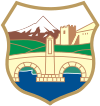| Transportation Center Skopje Транспортен центар Скопје | ||||||||||||||||
|---|---|---|---|---|---|---|---|---|---|---|---|---|---|---|---|---|
 Skopje Train and Bus Station from Mount Vodno Skopje Train and Bus Station from Mount Vodno | ||||||||||||||||
| General information | ||||||||||||||||
| Location | Bul. Kuzman Josifovski Pitu 1000 Skopje Greater Skopje North Macedonia | |||||||||||||||
| Coordinates | 41°59′27″N 21°26′47″E / 41.9909°N 21.4465°E / 41.9909; 21.4465 | |||||||||||||||
| Owned by | Makedonski Železnici | |||||||||||||||
| Line(s) | Skopje - Tabanovce Skopje - Veles Skopje - Kičevo Skopje - Thessaloniki | |||||||||||||||
| Platforms | 6 | |||||||||||||||
| Tracks | 10 | |||||||||||||||
| Train operators | ŽRSMT | |||||||||||||||
| Construction | ||||||||||||||||
| Structure type | At-grade | |||||||||||||||
| Platform levels | 3 | |||||||||||||||
| Parking | Yes | |||||||||||||||
| Bicycle facilities | No | |||||||||||||||
| Accessible | ||||||||||||||||
| Architect | Kenzo Tange | |||||||||||||||
| Architectural style | Brutalism, Late Modernism | |||||||||||||||
| Other information | ||||||||||||||||
| Status | Staffed | |||||||||||||||
| Station code | 6500001 | |||||||||||||||
| History | ||||||||||||||||
| Opened | 27 July 1981 (1981-07-27) | |||||||||||||||
| Rebuilt | 1971-1981 | |||||||||||||||
| Electrified | 25 kV AC, 50 Hz | |||||||||||||||
| Services | ||||||||||||||||
| ||||||||||||||||
| ||||||||||||||||
The Transportation Center Skopje, or Skopje railway station (Macedonian: Транспортен центар Скопје Transporten centar Skopje, (Macedonian: Железничка станица Скопје Železnička stanica Skopje) is the main central passenger railway station and bus terminal in the Republic of North Macedonia capital Skopje. It was built after the 1963 Skopje earthquake that destroyed the original station buildings, and much of the city. There are 10 tracks placed on a massive concrete bridge 2 kilometres (1.2 mi) long. The station is served by Long-distance trains to Belgrade, Thessaloniki, Athens and Ljubljana, and Express routes to Thessaloniki, via Vienna that serve Skopje twice daily, once going to Thessaloniki and second time returning to Vienna, passing through Belgrade and Ljubljana. The Skopje railway station is 15 min walking from the main square Makedonija.
History
The station was built following the 1963 Skopje earthquake that hit on 26 July 1963 which destroyed the Original station buildings. The old station building has become a symbol of the earthquake, with the clock stopped at 5.17 and now houses the Museum of the City of Skopje (Muzej na grad Skopje). After the earthquake, a project was started for a major reconstruction of the city, authored by Kenzo Tange, a Japanese architect, but which has not been fully implemented. The station was rebuilt in the Brutalist style of architecture. It was completed in 1981.
The construction is supported by earthquake-proof concrete pillars and covered by a tubular platform hall. Below the platforms are the counter and waiting rooms, which are separated from the street by glass facades. The interiors are designed with exposed concrete walls and ceilings in the Brutalist style. The bus station located under the tracks was opened in 2004.
The station was originally designed for 18 million passengers per year, but this was never never fully realised, as a result five of the ten track troughs remained unused. After the collapse of Yugoslavia, the structural condition of the station complex deteriorated increasingly. From 2014 to 2015, Makedonski Železnici Infrastructurea renovated the station for 2.5 million euros. In 2017, the station was used by 193,000 passengers.
In 2020 The EU Delegation North Macedonia funded the City of Skopje in turning a corner of its transport centre into an urban bike-parking, thus responding to the needs of a constantly growing number of cyclists. It was termed Veloshtad, from velosiped = bicycle and ploshtad = square.
Services
The main north–south line from Niš in Serbia to the port of Thessaloniki in Greece on the Aegean Sea (Corridor X), passes Skopje. Intercity trains link Skopje with, Kumanovo, Zelenikovo, Veles, Negotino (Kavadarci), Demir Kapija, Miravci (Valandovo) and Gevgelija (Bogdanci) with Serbian Railways and Greek railways. Connections to Bulgarian State Railways are via Niš in Serbia and via Thessaloniki in Greece. Intercity trains from Kosovo Railways link Skopje with Pristina.
Gallery
-
Old station building, rebuilt in 1940, and destroyed in 1963. Today it houses a museum, April 2010.
-
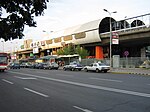 Part of the "Transport Center" complex in Skopje, which includes the Central Railway Station, the Intercity Bus Station, public city transport hub, postal hub, and a traffic control center.
Part of the "Transport Center" complex in Skopje, which includes the Central Railway Station, the Intercity Bus Station, public city transport hub, postal hub, and a traffic control center.
-
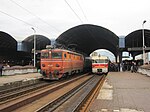 Mid-afternoon at Skopje. On the left, 441.107 on the daytime service from Beograd to Thessaloniki which sits at Skopje for about half an hour. On the right, DMU on a late departing service to Kičevo., April 2010.
Mid-afternoon at Skopje. On the left, 441.107 on the daytime service from Beograd to Thessaloniki which sits at Skopje for about half an hour. On the right, DMU on a late departing service to Kičevo., April 2010.
-
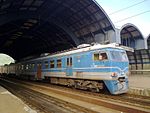 EMU MŽ 412 at Skopje train station, June 2011.
EMU MŽ 412 at Skopje train station, June 2011.
-
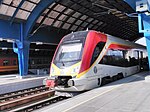 DMU MŽ 711 at Skopje train station, April 2017.
DMU MŽ 711 at Skopje train station, April 2017.
References
- "Transportation Center Skopje". Architectuul. Retrieved 14 May 2024.
- "Skopje travel".
- "Од изградбата на Железничката станица во Скопје". Македонска Архитектура. Retrieved 22 January 2021.
- "Skopje | how to get in Skopje - Skopje transport".
- ^ Robert Home (2007), Reconstructing Skopje, Macedonia, after the 1963 earthquake: The Master Plan forty years on, Papers in Land Management, 7, p. 12
- ^ Niebyl, Donald. "Skopje's 1963 Quake: From Ruins to Modernist Resurrection". www.spomenikdatabase.org. Retrieved 14 May 2024.
- "EU 'painted' Skopje Transport Centre with messages for eco-mobility and healthy lifestyle | EEAS". www.eeas.europa.eu. Retrieved 14 May 2024.

